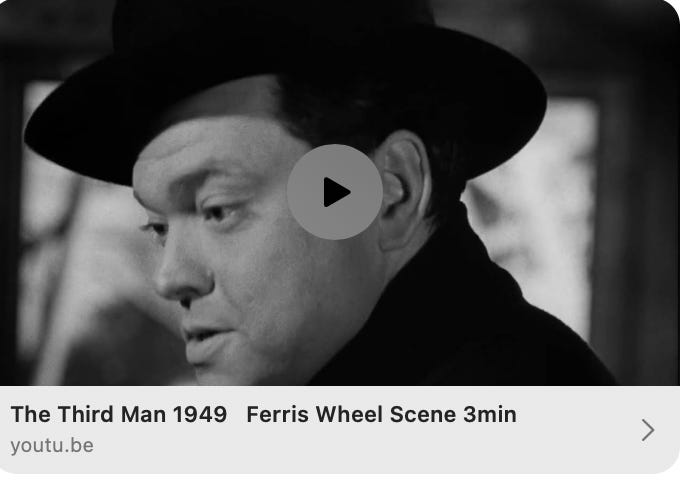The Film Scene that Foretold Our Current Moral Catastrophe
On the Giant Ferris Wheel in Graham Greene's film noir classic, The Third Man.
By JOHN LEAKE
It’s one of the most memorable scenes in all of cinematic history, and it’s the scene that inspired me to become a true crime author. In 2001 I lived in Vienna, around the corner from the Burgkino (Burg Cinema) which still played the 1949 film noir classic The Third Man on its big screen every weekend. I spent many a dreary winter Sunday afternoon watching the film.
Based on the novella and screenplay by Graham Greene, The Third Man is a crime story about Harry Lime—an American running a medical charity in Vienna, who makes a killing selling penicillin on the bombed out, impoverished city’s black market. To increase his profits, he cuts the drug with other substances, thereby destroying its efficacy and causing the patients (including children) to die horribly from their infections.
In the film’s most iconic scene, the good guy (played by Joseph Cotton) meets his old friend Harry Lime (played by Orson Welles) on the Giant Ferris wheel in the Vienna Prater amusement park and tries to appeal to his conscience. At the wheel’s apex, the charismatic Harry opens the door, points down to people walking on the ground below, and says:
Look down there. Would you really feel any pity if one of those dots stopped moving forever? If I offered you twenty thousand pounds for every dot that stopped, would you really, old man, tell me to keep my money, or would you calculate how many dots you could afford to spare? Free of income tax, old man. Free of income tax. … Nobody thinks in terms of human beings. Governments don’t, why should we? They talk about the people and the proletariat; I talk about the suckers and the mugs. It’s the same thing. They have their five-year plans, and so have I.
I sensed that Graham Greene might have based the story on something he’d witnessed or heard about. Doing some research, I learned that Harry Lime was probably based on the British spy Harold “Kim” Philby, with whom Greene worked in British intelligence during World War II. Greene, it seems, discovered that Philby was a Soviet double agent long before he was exposed as such in 1963. Instead of ratting out his friend, he kept it to himself and left the intelligence service in 1944. Several pieces of evidence suggest that when he wrote The Third Man a few years later, he based it on his conflicted friendship with Philby.
John le Carré was also fascinated by Graham Greene and Kim Philby, and his thriller Tinker, Tailor, Soldier, Spy—one of my all-time favorites—was inspired by the Philby story. His novel The Constant Gardener was published in 2001, and I read it with great interest. The story wasn’t set in Cold War Europe, but in Kenya, where a British diplomat’s wife is brutally raped and murdered. Upon closer examination, the diplomat realizes that she was about to reveal a horrifying crime committed by a pharmaceutical company, which murdered her in order to prevent the exposure.
The novel’s plot was reminiscent of a controversial drug trial performed by Pfizer in Kano, Nigeria in 1996 during a meningococcal outbreak. For the trial of its new antibiotic, trovafloxacin, Pfizer gave 100 children this new drug. The control group of 100 other children received the standard anti-meningitis treatment at the time—a drug called ceftriaxone. However, for the control group, Pfizer administered a substantially lower dose of ceftriaxone than the drug’s FDA-approved standard.
When the reduced dosing in the control group was discovered, it raised the suspicion that Pfizer did this in order to skew the trial in favor of its new drug. Five of the children who received trovafloxacin died, while six who received the reduced dose of ceftriaxone died. Other children apparently suffered grave injuries from the administration of the experimental antibiotic without their informed consent. The investigation and litigation that ensued was the stuff of a thriller, involving private investigators, bribery, blackmail attempts, and disappearing records. Thirteen years later, in 2009, Pfizer settled out of court with the plaintiffs.
In his author’s note, le Carré claimed that nobody and no corporation in the novel was based on an actual person or corporation in the real world.
But I can tell you this. As my journey through the pharmaceutical jungle progressed, I came to realize that, by comparison with the reality, my story was as tame as a holiday postcard.
It seems to me that no one apart from the incomparable Orson Welles could capture the full wicked charisma of Harry Lime. No matter how many times I watch the scene, I still marvel at the demonic charm with which he delivered his lines.






I grew up so sheltered. I really didn’t believe that there were so many people willing to trade in other peoples’ lives for profit. This pandemic has been jarring. I knew things were going on before, but this pandemic has brought a whole new level of evil into the daylight.
Adding this to “the watch list”